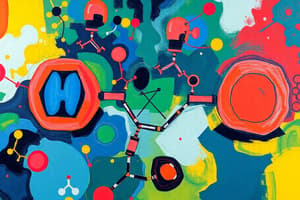Podcast
Questions and Answers
What is the precursor to serotonin and melatonin?
What is the precursor to serotonin and melatonin?
- Glutamic acid
- Tryptophan (correct)
- Cholesterol
- Arachidonic acid
What is the characteristic of steroid hormones in terms of solubility?
What is the characteristic of steroid hormones in terms of solubility?
- Lipid soluble (correct)
- Water soluble
- Both water and lipid soluble
- Depends on the specific hormone
Which hormone is derived from cholesterol and plays a role in calcium regulation?
Which hormone is derived from cholesterol and plays a role in calcium regulation?
- Norepinephrine
- Epinephrine
- 1,25 dihydroxy vitamin D3 (correct)
- Melatonin
What is the precursor to histamine?
What is the precursor to histamine?
What is the characteristic of catecholamine hormones in terms of solubility?
What is the characteristic of catecholamine hormones in terms of solubility?
What is the precursor to eicosanoids?
What is the precursor to eicosanoids?
What is the typical duration of hormone activity after being released?
What is the typical duration of hormone activity after being released?
What type of fatty acids do eicosanoids derive from?
What type of fatty acids do eicosanoids derive from?
What is a key factor that determines the concentration of hormones in blood and extracellular fluid?
What is a key factor that determines the concentration of hormones in blood and extracellular fluid?
What is an example of an endogenous rhythm that affects hormone secretion?
What is an example of an endogenous rhythm that affects hormone secretion?
What characteristic of a hormone receptor is crucial for hormone-receptor interaction?
What characteristic of a hormone receptor is crucial for hormone-receptor interaction?
What type of hormone is produced in response to a biological need?
What type of hormone is produced in response to a biological need?
What is the characteristic of peptide/protein hormones?
What is the characteristic of peptide/protein hormones?
What is the process of converting preprohormone to prohormone?
What is the process of converting preprohormone to prohormone?
What is the characteristic of thyroid hormones?
What is the characteristic of thyroid hormones?
What is the function of signal peptides in preprohormones?
What is the function of signal peptides in preprohormones?
What are the two groups of hormones derived from tyrosine?
What are the two groups of hormones derived from tyrosine?
What is the role of hormones in the body?
What is the role of hormones in the body?
Flashcards are hidden until you start studying
Study Notes
Amino Acid Derivatives
- Catecholamine hormones are neurohormones and neurotransmitters, including epinephrine and norepinephrine, produced by the adrenal gland and water-soluble.
- Tryptophan is the precursor to serotonin and melatonin.
- Glutamic acid is converted to histamine.
Steroid Hormones
- Derived from cholesterol and differ only in ring structure and side chains.
- Lipid-soluble and not packaged, but synthesized and immediately released.
- All steroid hormones are derived from the same parent compound: cholesterol.
- Not water-soluble, so carried in the blood complexed to specific binding globulins.
- In some cases, a steroid is secreted by one cell and converted to the active steroid by the target cell (e.g., androgen to estrogen).
Fatty Acid Derivatives (Eicosanoids)
- Arachidonic acid is the precursor of hormones.
- Stores of arachidonic acid are present in membrane lipids and released through the action of various lipases.
- Eicosanoids are rapidly inactivated by being metabolized and are typically inactive for only a few seconds.
- The principal group of hormones of this class are prostaglandins, prostacyclins, leukotrienes, and thromboxanes.
Regulation of Hormone Secretion
- Sensing and signaling: a biological need is sensed, the endocrine system sends out a signal to a target cell whose action addresses the biological need.
- Key features of this stimulus-response system are:
- Control of endocrine activity
- Concentration of hormones in blood and extracellular fluid are determined by rate of production, delivery, and degradation/elimination.
Hormone-Receptor Interaction
- Receptor: a protein that binds to a ligand with high affinity and low capacity.
- Requires a receiver to get the message (receptor).
Principal Functions of Hormones
- Maintenance of the internal environment in the body (maintaining the optimum biochemical environment).
- Integration and regulation of growth and development.
- Control, maintenance, and instigation of sexual reproduction.
Types of Hormones
- Peptide/protein hormones are water-soluble (e.g., ADH, oxytocin, insulin).
- Steroid hormones are lipid-soluble and derived from cholesterol.
- Thyroid hormones (T3, T4) and catecholamines (dopamine, norepinephrine, epinephrine) are derived from tyrosine.
- Tryptophan-based hormones include serotonin and melatonin.
Studying That Suits You
Use AI to generate personalized quizzes and flashcards to suit your learning preferences.




